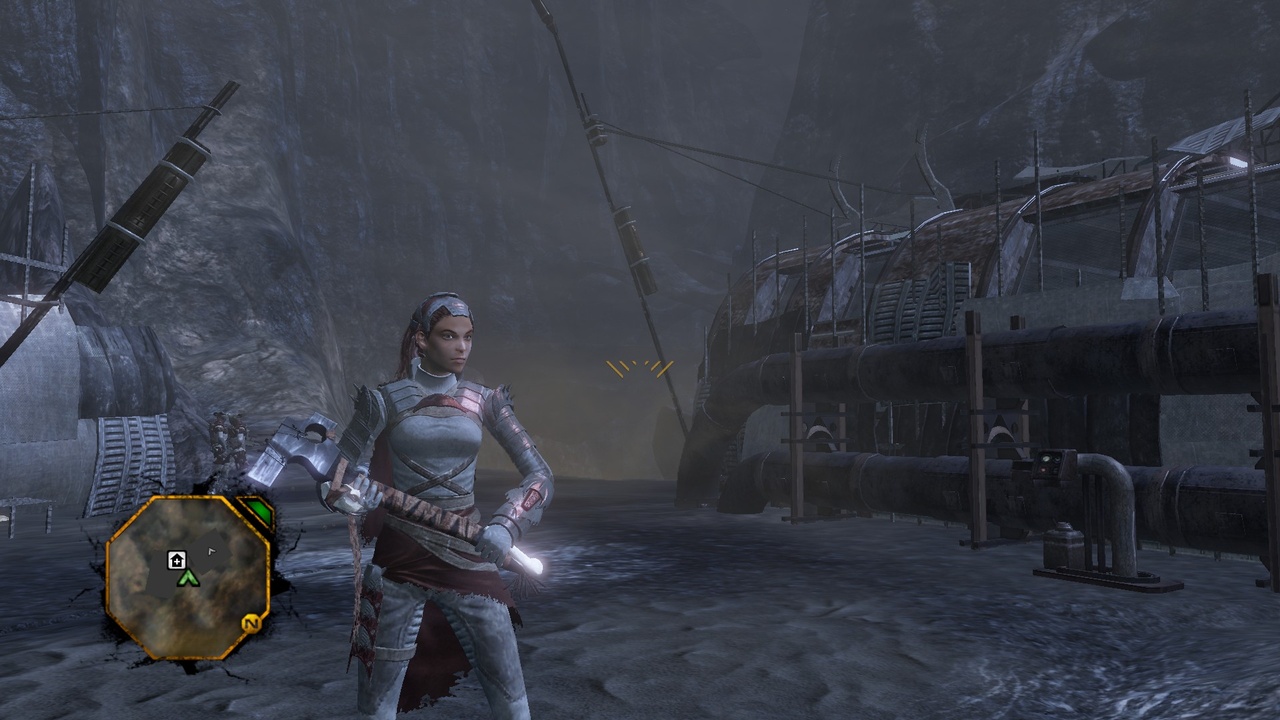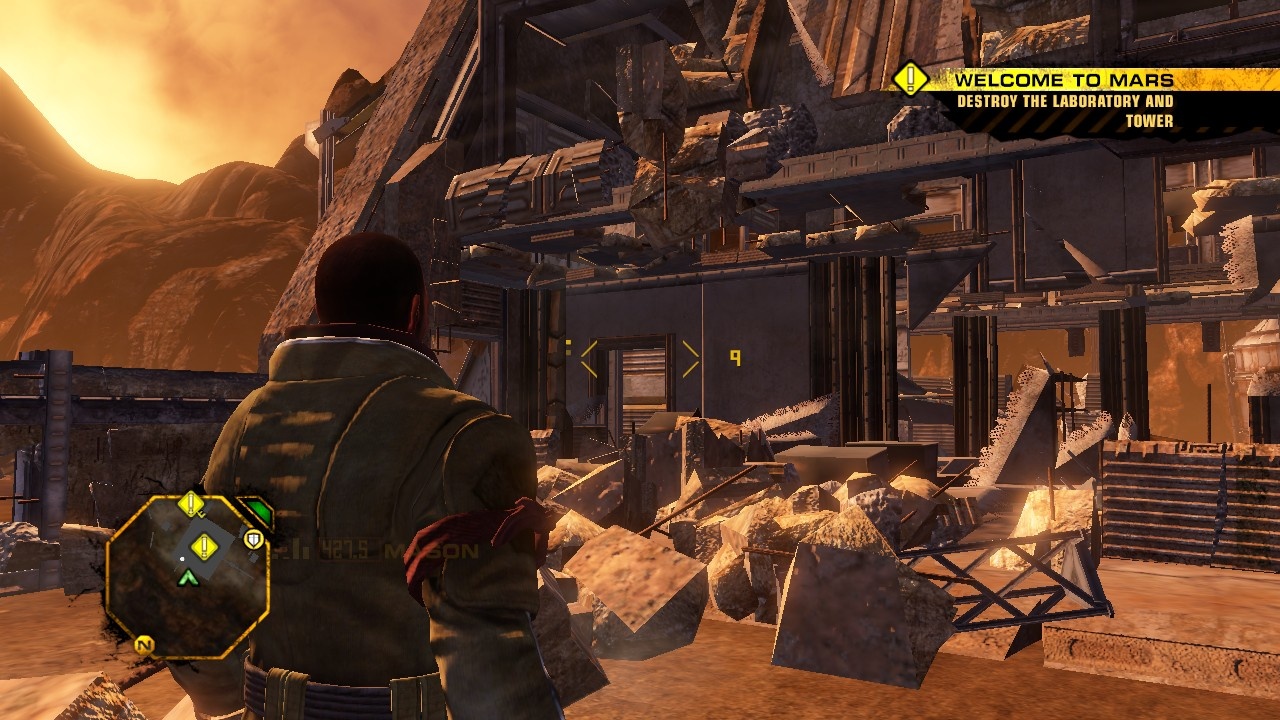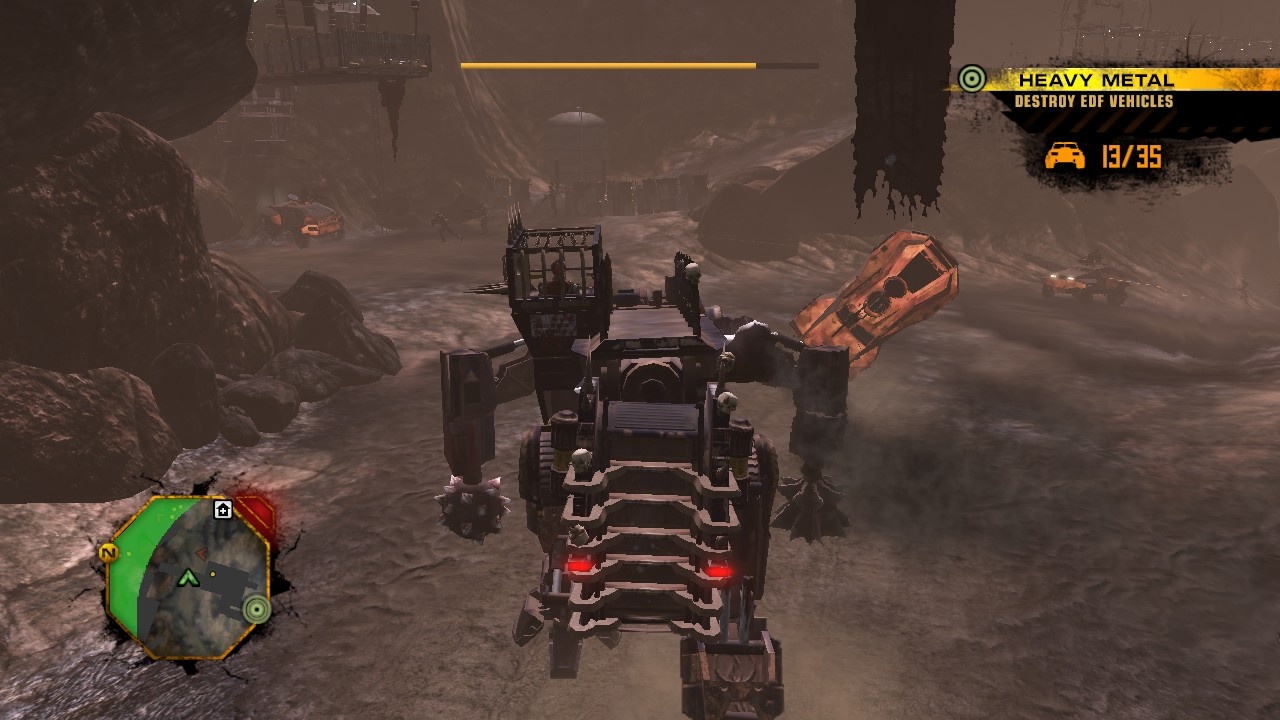Of all the weapons you'll find in Red Faction: Guerrilla, the simple sledgehammer is one of the best. This powerful object has the ability to bring down entire buildings, giving you a tactile feeling of gleeful abandon as you watch your character leave nothing but rubble and havoc in his trail. The brutish, direct sledgehammer exemplifies what the excellent Red Faction: Guerrilla is all about. Destruction is this game's currency, and it puts its considerable wealth to good use. Mars is yours to annihilate, so though the main story is uninvolving and the action is repetitive, you'll find plenty to like in the game's mayhem-filled single-player campaign and impressive multiplayer offerings. And while some significant performance issues prevent the PC version from being the smoothest Guerrilla experience, it is the most complete, coming packed with the Demons of the Badlands downloadable content, an extra multiplayer mode, more maps, and enhanced visuals.
Mayhem is built into Guerrilla's DNA, and its impressive physics engine realistically showcases destruction on a massive scale. The game ditches the deformable landscapes that were a staple of its predecessors and instead offers the ability to blow apart anything in the game. Any man-made object can be reduced to rubble, and every structure or vehicle--and every one of its parts--features its own unique physical properties. Everything from smokestacks to bridges appears to have been built with real-world engineering principles in mind, and you can see the various supports and reinforcements in their design. So to demolish a small building, you needn't take out all its walls--simply identify its support columns, take those out with charges, and watch the whole thing implode. All of this destruction is performed in real time, which means no structure collapses in the same way.
The realistic nature of this rampant destructibility is the standout feature of Guerrilla, and it will affect many of your gameplay decisions. Cover, for example, is at best a temporary haven for you and your enemies, since all walls can be demolished. Height is also of little concern--if an enemy sniper is perched on a building, you can easily destroy the floor underneath him. You can stop pursuers by blowing up a bridge as you pass it, or even level an entire building to kill all of the troops inside. It's hard not to get swept up in all the damage you can cause, and you'll find yourself wanting to lay waste to an object just to see how it crumbles simply because it's so much fun.
If it sounds like the game is frenetic and chaotic, that's because it can be. Despite the fact that your character, Alec Mason, is a guerrilla--a member of the underground group Red Faction, which is trying to take out the all-powerful Earth Defense Force (EDF)--there's little scope for anything other than full-volume action, even if you are trying to approach a mission with subtlety. Mason is initially an unwilling recruit to Red Faction, joining only after his brother is killed by EDF soldiers. What follows is a lengthy main storyline which is fairly cliched for the most part. Mason's motivation for revenge doesn't ring that strongly throughout the campaign, and there are very few twists and turns to keep the plot engaging.
Story, for the most part, takes a backseat to Mason's continuing mission to free Mars. The EDF have total control of the six sectors of the planet, oppressing its population of miners with a heavy security presence and upfront brutality. To free the planet, you'll have to do it sector by sector. Each sector will have its own level of EDF control that you'll have to lower while at the same time raising the population's morale. The game's eight different mission types will do one or the other, and in many cases they'll do both. Lowering EDF control opens up new story missions which will move Guerrilla's main narrative forward, while improving morale means more of the population will randomly jump in and support you when you get into a fight with the EDF. On the surface, the mission types are varied--for example, protect a settlement, join a group of rebels in storming an EDF stronghold, intercept an enemy shipment, destroy EDF property--but the game's aggressive AI means most missions will end up in large explosions and a hail of gunfire. You may want to take a more circumspect approach, such as finding an unguarded path into a group of structures that need to be taken down, but as soon as the first explosion hits, EDF troopers will swarm to your position to try to take you down with force. While this doesn't make the action one-dimensional, it does make it one note. Sure, you can blow stuff up in a variety of interesting and creative ways, but in the end, it's still the same thing--blowing stuff up.

It's to the game's credit (and to the credit of its remarkably robust physics engine) that despite repetitiveness, Guerrilla's destruction is engaging and entertaining for the 15 or so hours it will take you to get through the single-player campaign. The first DLC episode--Demons of the Badlands--is also included with the PC game and adds an extra few hours of solo destruction. Even after you finish the main game, you can go back into the world to complete any missions you may have skipped, as well as try your hand at the "insane" difficulty level you'll unlock after your first run through. The game is quite challenging even at lower difficulty levels, and you'll find yourself pushed to survive most large-scale fights at medium difficulty. Guerrilla has a cover function which will let you stick to walls, but it's not something you can rely on--you'll sometimes fail to stick to objects properly (particularly low bits of cover), and popping out to shoot can cause you to leave cover completely.
Thankfully, the rest of Red Faction: Guerrilla's controls are solid, particularly its shooting mechanic, which feels even better than its console counterparts thanks to the extra precision a mouse provides. You'll be able to equip only four weapons at a time, but you can quickly switch between them by scrolling the mousewheel or tapping hotkeys. Most are typical weapons--there are pistols, machine guns, shotguns, rocket launchers, and sniper variants--but Guerrilla does feature some unique weapons, such as the killer disc-spewing grinder and the electricity-pulsing arc welder. By far the most interesting is the nano rifle, a weapon which sends out a bolt of microscopic nanites that corrode anything they hit--and this includes people as well as buildings.
Driving is similarly strong, the only caveat being that most vehicles are floaty and too easy to flip (although any science geek can probably justify this by pointing to Mars' lower gravity compared to Earth). You won't have the variety of vehicles found in other open-world games, but the ones that are here seem functional to a mining colony and fit within the gameworld. There are large earth-moving vehicles, smaller two-person transports, and plenty of trucks, with a surprising number of them packing onboard weapons. You'll also run across beefy mech-like walkers, which are great to pilot against hordes of EDF soldiers--these are pretty rare, however, but they're so much fun you'll wish there were more instances when you could use them.

You won't get to drive any vehicles in Guerrilla's multiplayer mode, but it does offer plenty of unique experiences you won't find in the single-player game. The game supports up to 16 players online and features the stock standard deathmatch, team deathmatch, and capture-the-flag variants. All of the single-player game's destructibility adds another level of strategy to matches, because you're only ever one sledgehammer blow away from instant death, no matter how thick your cover. This makes all matches tense affairs, and camping is a definite no-no. Added to this are new items exclusive to multiplayer which can radically affect how you play. The main additions are 10 different backpacks which act as offensive, defensive, or support aids during combat. The rhino backpack, for example, will allow you to charge straight through walls at a hiding player, while the thrust backpack can propel you quickly up a few levels to take out snipers. The stealth pack, on the other hand, will make you invisible for short periods of time, while the heal pack will quickly regenerate lost health.
Multiplayer also gives you the power to rebuild--an ability which features heavily in two of Guerrilla's three unique online modes. The reconstructor gun can repair damaged or destroyed structures and is used in the Siege and Damage Control modes. Siege has two teams taking turns to see how much damage they can do to a map, while Damage Control sees two teams fighting for control of three structures. To gain control of a structure, you need to destroy it first before rebuilding it for your team. The third unique online mode is Demolition, where one player on a team is randomly chosen as a destroyer. To gain points, the destroyer must wreak as much havoc as possible. These new modes are fun, and Damage Control in particular is hectic as your team continually scrambles to destroy and repair the various checkpoints.
When it comes to multiplayer, the PC version trumps the console games because it has more maps and a new mode called Bagman. The maps are a mix of already released DLC and yet-to-be-released content, so while they're nothing PlayStation 3 or Xbox 360 owners are locked out of, they are a welcome freebie. Guerrilla's online component, in fact, is a definite winner; while the player population on Windows Live was a bit sparse, games ran almost completely lag-free during testing, with the most noticeable issue being an occasional lapse between hitting an object with the sledgehammer and seeing it crumble. There's also an offline multiplayer mode called Wrecking Crew, where up to four players can take turns doing as much damage as they can to a certain area. Wrecking Crew is a fun little distraction at best, and it probably won't hold your interest considering the large scope of the game's online multiplayer offerings.

The area of Mars you'll traverse in Red Faction: Guerrilla is big even by open-world game standards, but there's not a lot to see. There are plenty of red hills, open plains, and dust, and what few populated areas there are seem sparse in comparison to other games in this genre. It's hard to fault the game for this--after all, this is what a human colony on Mars would conceivably look like--but it doesn't change the fact that you'll be looking at dirt a lot of the time in Guerrilla. That said, the game does look quite impressive, particularly on the high resolutions it supports. The textures on Mars and its architecture look realistic, as do many of the lighting effects with the various explosions and pyrotechnics. You'll pay a price for these good looks, however, because Guerrilla's frame rate stutters seriously during intense sequences of destruction. Visuals lag and even freeze for seconds at a time, a problem which doesn't dissipate even when the game is played at resolutions as low as 800x600. Playing in windowed mode seems to fix performance issues (even with visuals pumped up to 1920x1080), so here's hoping a patch is rushed out soon. Sound fares better--the game's voice actors do well with their limited scripts, and the various explosions, gunfire, building collapses, and other sound effects are uniformly impressive. The solid "thunk" you hear every time you use your sledgehammer is especially satisfying.
You'll end up hearing that "thunk" a lot in Red Faction: Guerrilla, but you'll never get tired of it because its deep, crunchy sound is tied so intrinsically to the satisfying visual destruction you see. Guerrilla's gameplay is similar--many of the missions may feel like they're at the same loud, all-out pace, but when devastation is this well presented, it's difficult not to get swept along by its primal energy. Red Faction: Guerrilla mixes a long and involving single-player campaign with a fun and satisfying online segment, with both adding up to a game that proves that a little chaos (or in this case, a lot) can be a positive thing.